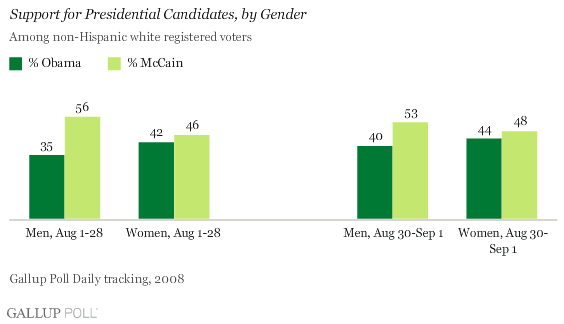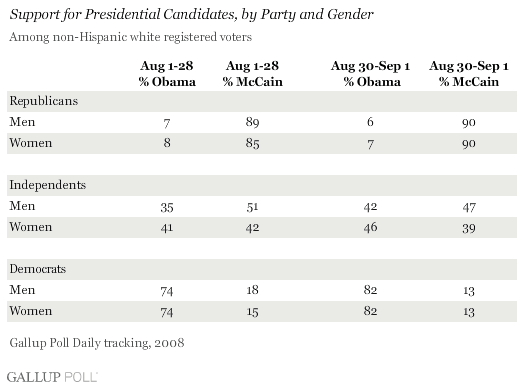PRINCETON, NJ -- An update on gender differences in white voters' presidential vote shows that Barack Obama's gains vis-à-vis John McCain in the days since the Democratic National Convention have come among independents and Democrats of both genders, but that McCain has actually gained slightly among Republican women. The preferences of Republican men have not changed.
The net effect of these patterns: Obama has registered significant overall gains among white men, but there has been no net change in his support among white women.

In August, McCain led Obama among non-Hispanic white men by 21 points; his lead is now 13 points. Among white women, McCain led Obama by 4 points, and McCain leads by the same amount today. This means that McCain's relative position among women has improved.
(Gallup's previous analysis shows that Obama has a huge lead among both black men and black women, and that he also leads among Hispanics, regardless of gender. The only racial or ethnic group among which there is a notable gender gap is non-Hispanic whites.)
Partisan Groups
One gains a better understanding of these gender differences among white voters by breaking the data into partisan groups.
Overall, this analysis shows that Obama's gains over the last week among white men are fairly straightforward. They occurred among both independent and Democratic men. There has been no change among Republican white men.
On the other hand, Obama's gains among independent and Democratic women appear to have been mostly offset by McCain's gains among Republican women.

Previous Gallup analysis has suggested that McCain's selection of a woman as his vice-presidential running mate might have the most impact on independent white women, who before the Democratic Convention were essentially split down the middle in terms of candidate support.
These data show, however, that at least initially, McCain has lost ground among both white independent women and white independent men (and among Democrats of both genders) since the convention and his vice-presidential selection.
Instead, the data suggest that McCain has in essence fought a rear-guard action of sorts among white women of his own GOP base, building their support to a degree even as he was losing support among independents and Democrats of both genders.
It is possible, but not provable with these data, that McCain's selection of a woman, Gov. Sarah Palin of Alaska, as his vice-presidential running mate may have had the effect of solidifying support among women of his own party.
The Republicans no doubt hope that this week's convention, and in particular Palin's address on Wednesday, will help them make inroads not only among white Republican women, but also among independent (and perhaps Democratic) women.
Survey Methods
Results for Aug. 1-28 are based on telephone interviews with 25,007 registered voters, aged 18 and older, conducted Aug. 1-28, 2008, as part of Gallup Poll Daily tracking. For results based on this total sample of registered voters, one can say with 95% confidence that the maximum margin of sampling error is ±1 percentage point. Results for Aug. 30-Sept. 1 are based on a sample of 2,772 registered voters, for which the maximum margin of sampling error is ±2 percentage points.
Interviews are conducted with respondents on land-line telephones (for respondents with a land-line telephone) and cellular phones (for respondents who are cell-phone only).
In addition to sampling error, question wording and practical difficulties in conducting surveys can introduce error or bias into the findings of public opinion polls.
To provide feedback or suggestions about how to improve Gallup.com, please e-mail feedback@gallup.com.
